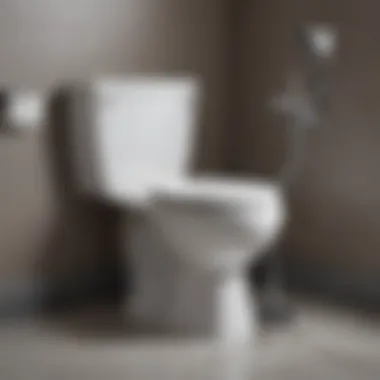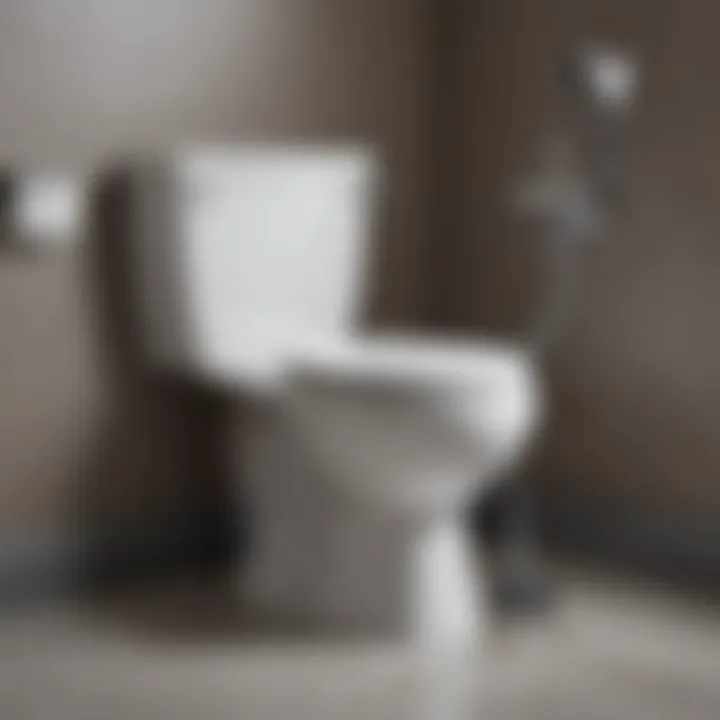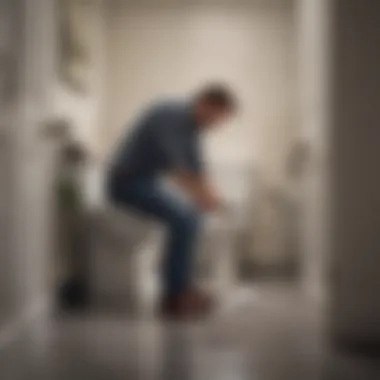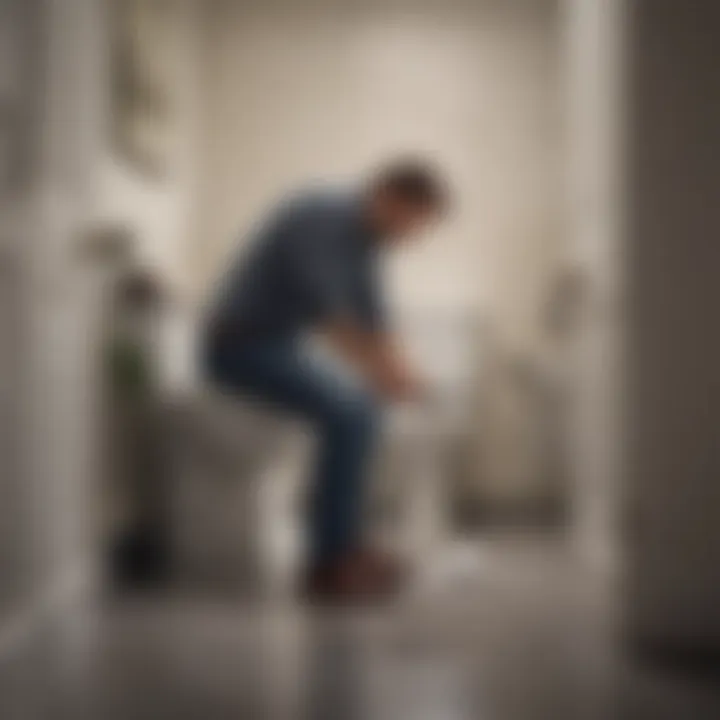The Best Unclogger for Toilets: A Comprehensive Guide


Intro
Choosing the right unclogger for toilets is essential for maintaining effective plumbing in your home. Clogged toilets can cause significant inconvenience and may even lead to costly repairs if not addressed properly. This comprehensive guide will evaluate various unclogging tools available, focusing on their effectiveness, ease of use, and practicality. By understanding the different types of uncloggers and their mechanisms, homeowners can make informed decisions that cater to their specific needs.
The relevance of this topic expands beyond mere convenience; it aligns with essential home maintenance practices. Knowing how to select the right unclogger not only saves time but can also prevent plumbing issues from escalating. Additionally, familiarizing oneself with these tools enhances one’s plumbing knowledge, making DIY repairs more manageable.
In the following sections, we will delve into the available options and analyze their strengths and weaknesses. We will also provide insights into scenarios in which certain unclogging tools would be most effective, ensuring readers leave with a robust understanding of toilet unclogging solutions.
Understanding Toilet Clogs
Toilet clogs are a common household issue that can disrupt daily routines and lead to potential plumbing complications. Understanding the nature of these clogs is essential for effective resolution and prevention. This section aims to unravel the complexities behind toilet clogs, highlighting their causes and emphasizing the significance of selecting the right unclogging tool.
Common Causes of Toilet Clogs
Numerous factors contribute to toilet clogs. Recognizing these can play a key role in managing clogs more effectively. Here are the most frequent causes:
- Excessive Toilet Paper: Using too much toilet paper at once is one of the leading causes. Toilets often struggle to process large quantities, causing blockages.
- Foreign Objects: Items like toys, sanitary products, and other non-flushable objects can lead to serious clogs. They disrupt the normal flow of waste.
- Tree Roots: In some cases, roots from nearby trees can infiltrate sewer lines, causing clogs far from the toilet itself. This requires more extensive repairs.
- Low-Flow Toilets: Some low-flow models may not use enough water to thoroughly flush waste. This can create a buildup over time, leading to clogs.
- Mineral Buildup: Hard water can lead to mineral deposits that narrow pipes and impede proper flow, increasing the likelihood of clogs.
Understanding these causes is vital. It not only aids homeowners in tackling existing clogs but also helps prevent future occurrences. Regular maintenance based on these insights can save significant time and costs.
The Importance of Choosing the Right Unclogger
Selecting the correct unclogging tool is crucial for several reasons. Firstly, using the wrong tool might not just fail to resolve the issue but may also damage the plumbing system. For instance, chemical cleaners can corrode pipes if overused or misapplied. Secondly, the right tool can enhance efficiency. Knowing when to use a plunger versus a toilet auger can make the clog removal process smoother and quicker. Lastly, the effectiveness of the chosen method matters. An optimal unclogging tool tailored to the specific situation ensures better results and minimizes future plumbing problems.
Choosing the right unclogger not only resolves the current issue but also contributes to the long-term health of your plumbing system.
Types of Unclogging Tools
Unclogging tools are essential in addressing toilet blockages, a common issue in many households. Various tools serve different purposes, making it crucial to understand what each type offers. This understanding can save time and effort when faced with a clog. The right tool can effectively resolve the problem while minimizing damage to the plumbing system. Choosing the correct tool is important to ensure the effectiveness of the unclogging process, as each tool has its specific strengths and applications.
Plungers: A Classic Solution
Plungers are often the first line of defense against toilet clogs. They are simple yet effective tools that use a suction method to dislodge blockages. This straightforward approach contributes significantly to their popularity among homeowners.
Types of Plungers
There are mainly two types of plungers: the cup plunger and the flange plunger. The cup plunger has a flat, rounded rubber cup and is best suited for flat surfaces. In contrast, the flange plunger features an extended rubber flap, making it more effective for toilets as it conforms better to the toilet bowl shape. The choice between these types can impact the efficiency of unclogging. If a clog is severe, using the flange plunger might yield better results due to its enhanced suction capability.
How to Use a Plunger Effectively
Using a plunger effectively requires some technique. First, ensure there is enough water in the toilet bowl to cover the rubber cup. Next, position the plunger directly over the drain opening and push down firmly to create a seal. Then, pull up quickly to build suction, repeating this motion several times. This method allows for effective pressure changes that can dislodge a clog. Following these steps can increase the chances of successfully clearing the blockage.
Toilet Augers: For Stubborn Clogs
For more persistent clogs, toilet augers can be quite beneficial. Unlike plungers, which rely on suction, augers use a coiled wire to break up or remove the blockage. This tool can reach deeper into the plumbing system, making it a reliable choice for stubborn clogs that refuse to yield to other methods.
How Toilet Augers Work
Toilet augers typically consist of a long, flexible cable with a handle at one end and a corkscrew-like tip at the other. When inserted into the toilet bowl and rotated, the auger drills through clogs made of organic matter or non-dissolvable items. The unique feature of this tool lies in its ability to reach clogs not accessible by plungers. It is particularly effective for clearing blockages located further down the toilet trap, where simple suction may not penetrate.
When to Use a Toilet Auger


A toilet auger should be your go-to when other methods fail. If a plunger does not yield results after multiple attempts, it indicates that the clog may be beyond the reach of suction alone. In such cases, using an auger can address the issue more effectively. However, it requires some skill to handle, so using it carefully is critical to avoid damaging the toilet interior.
Chemical Drain Cleaners: Pros and Cons
Chemical drain cleaners offer an alternative method for unclogging toilets. They dissolve the materials causing blockages, providing a convenient solution when physical tools are ineffective. However, these solutions come with both advantages and disadvantages that must be weighed carefully.
Types of Chemical Cleaners
Chemical cleaners primarily fall into two categories: caustic and enzymatic. Caustic cleaners contain harsh chemicals that generate heat and break down organic materials. Alternatively, enzymatic cleaners use natural bacteria to digest waste. Each type has strengths; while caustic cleaners offer faster results, enzymatic options are often more eco-friendly. The choice largely depends on the clog severity and personal environmental considerations.
Safety Precautions
Using chemical cleaners requires caution. Read product labels for application instructions and safety warnings. Use gloves and eye protection to avoid skin and eye irritation. Additionally, ensure the bathroom is well-ventilated to minimize inhalation of fumes. While chemical cleaners can be effective, neglecting safety precautions can lead to harmful reactions or accidents.
Hydro Jetters: An Advanced Option
Hydro jetters represent a more advanced unclogging tool that utilizes high-pressure water to clear blockages. This method is especially effective for clearing away build-up of grease, soap scum, and other debris that may accumulate within plumbing systems over time.
How Hydro Jetters Function
Hydro jetters consist of a hose connected to a water source that delivers high-pressure water streams into the piping system. The unique feature of this tool is its ability to clean pipes thoroughly, not just clear blockages. Hydro jetting is potent; operators can clear even severe clogs and restore flow without damaging pipes. This approach is particularly useful for larger plumbing systems in commercial settings.
Ideal Situations for Use
Hydro jetting is ideal for situations where traditional methods fail or when regular maintenance is needed to prevent buildup. It suits homes with long plumbing runs or frequent clogs. However, using hydro jetters may require professional assistance due to the equipment's complexity and the potential risk of damaging older pipes.
Comparing Unclogging Tools
When it comes to resolving toilet clogs, understanding the different unclogging tools becomes critical. Each tool brings unique advantages and drawbacks. Therefore, comparing these tools can help homeowners make informed decisions when faced with such plumbing issues. That could save both time and money.
Effectiveness of Each Tool
Various unclogging tools work uniquely. For instance:
- Plungers: Ideal for most basic clogs, they create suction to dislodge blockages. The effectiveness depends on the type of plunger used. For example, a flange plunger is designed specifically for toilets and tends to work better than a cup plunger.
- Toilet Augers: These are more effective for stubborn clogs deep within the toilet trap or the drain line. They can reach further than plungers and can break apart and remove more complex blockages.
- Chemical Drain Cleaners: Their effectiveness varies. They can dissolve clogs made from organic material, but they are less effective on solid objects like toys or toilet paper.
- Hydro Jetters: These machines use high-pressure water jets to clear serious clogs and can restore flow in pipes significantly better than many other tools.
A homeowner must assess their specific situation to choose the best tool.
Ease of Use: Which Tool is Best for Homeowners?
Ease of use is paramount for homeowners who are not skilled in plumbing. Here’s a breakdown:
- Plungers: They are user-friendly, require no special skills, and provide immediate feedback. Most homeowners are comfortable using them.
- Toilet Augers: While slightly complex, they are still manageable for most DIY enthusiasts. Familiarizing oneself with the tool’s operation is all it takes.
- Chemical Drain Cleaners: They are straightforward as well, but they require caution in use due to their harsh chemicals. Safety precautions need to be followed closely.
- Hydro Jetters: Generally require professional operation. Their complexity makes them less favorable for typical homeowners.
Cost Analysis: Budgeting for Unclogging Solutions
Understanding the cost aspect can also guide homeowners toward the right choice:
- Plungers: These tend to be inexpensive, with prices usually ranging from $5 to $30.
- Toilet Augers: Costs vary, often between $20 and $100, depending on quality and brand.
- Chemical Drain Cleaners: Usually priced between $10 and $25. However, continuous reliance on these can eventually become costly due to potential plumbing issues.
- Hydro Jetters: Hiring a professional can be expensive. Typical service charges may start from $150 and can increase significantly based on severity of the clog.
Considering these elements will help in budgeting effectively for unclogging tools while ensuring that essential plumbing repairs are conducted.


DIY Solutions for Unclogging Toilets
DIY solutions for unclogging toilets can be a cost-effective and practical method for homeowners. Understanding how to tackle toilet clogs on your own not only saves money but also gives you the tools and knowledge necessary to handle plumbing issues effectively. It encourages a sense of independence and can alleviate the stress of waiting for a professional to arrive.
One of the main benefits of DIY unclogging is the empowerment it provides. Knowing how to respond promptly can prevent minor issues from escalating. Simple tools and techniques often resolve clogs before they become significant problems. However, it’s important to be cautious; improper techniques can cause damage to your plumbing system or worsen existing clogs.
Preparation Steps Before Attempting to Unclog
Preparation is crucial before attempting to unclog a toilet. Here are several steps to consider:
- Gather Necessary Tools: Before starting, ensure you have the right tools, such as a plunger, toilet auger, or even some baking soda and vinegar.
- Protect Your Floors: Place towels or newspapers around the base of the toilet to absorb any spills or overflow.
- Wear Appropriate Attire: It is advisable to wear gloves and old clothes. Clogs can get messy, and staying safe and clean is important.
- Shut Off Water Supply: If you anticipate a major spill, locate the water shut-off valve behind the toilet and turn it off to prevent any flooding.
- Assess the Severity: Determine whether it is a simple blockage or something requiring more invasive methods.
Taking these steps helps prevent additional mess and ensures a more effective unclogging process.
Step-by-Step Guide for Using Common Tools
Using common tools can be straightforward. Here’s a simple guide on how to use a plunger and a toilet auger:
Using a Plunger:
- Choosing the Right Plunger: Ensure you’re using a flange plunger, which is best suited for toilets due to its shape that provides better suction.
- Create a Seal: Position the plunger over the drain hole and press down firmly to create a seal.
- Push and Pull: Use a steady and vigorous push-pull motion. This action can dislodge the clog effectively. Repeat for 15-20 seconds.
- Check Flush: After plunging, flush the toilet to see if the clog is cleared.
Using a Toilet Auger:
- Insert the Auger: Insert the auger into the toilet bowl. Ensure the protective rubber sleeve is facing the bowl.
- Crank the Handle: Turn the handle clockwise until you feel resistance. This means you’ve hit the clog.
- Break the Blockage: Continue cranking to break up or hook the clog. Once you feel it loosen, retract the auger.
- Final Flush: Flush the toilet to ensure everything has passed.
Mastering these tools will empower you to handle most minor clogs without external help.
In summary, DIY unclogging can save time and minimize plumbing-related issues. With the right preparation and understanding of the tools, many homeowners can take control of their toilet maintenance.
When to Call a Professional
Recognizing when to call a professional is crucial for managing toilet clogs effectively. While DIY solutions are available, there are occasions where expertise becomes essential. Understanding specific signs that emergencies exceed basic unclogging efforts can spare homeowners significant trouble. Moreover, professional assistance often brings tools and knowledge that enhance resolution times for severe issues.
Signs that Indicate a Professional is Needed
Some situations simply warrant professional help. Homeowners should be vigilant and attentive to the following signs:
- Repeated Clogs: If clogs persist even after using various unclogging methods, it might indicate a more significant issue in the plumbing system.
- Multiple Fixtures Draining Slowly: Slow drains in various areas of the home can suggest a blockage in the main sewer line, which requires professional assessment.
- Unpleasant Odors: Foul smells indicate backups. This can point towards a broken pipe or an obstruction that needs immediate attention.
- Gurgling Sounds: Unusual noises from toilets or drains often suggest trapped air in the plumbing system. This can be symptomatic of a serious blockage.
- Overflows: If your toilet overflows frequently, it is not just an inconvenience; it can damage your property and needs professional intervention.
Recognizing these signals can prevent further complications and ensure swift resolution.
Understanding the Costs of Professional Help
The costs associated with hiring a plumbing professional vary. Factors influencing pricing include location, complexity of the issue, and time required for repairs. Understanding these factors can aid in budgeting for plumbing services:
- Service Call Fees: Many plumbers charge a base fee for coming to your home, regardless of the work done.
- Hourly Rates: Plumbers often bill hourly, so knowing the average rate in your area can help. As of 2023, this can range between $50 and $150 per hour.
- Nature of Work: Simple unclogging may cost less than installing new pipes or replacing a toilet, thus understanding your specific need can aid in planning.
- Emergency Services: After-hours or weekend calls can incur higher fees due to their unscheduled nature.
In summary, while the initial expenditure for professional help may seem steep, it can ultimately save homeowners from extended damage or costly repairs down the line. Therefore, weighing costs versus potential damage from prolonged clogs is essential.
Maintaining a Clog-Free Toilet


The significance of maintaining a clog-free toilet cannot be overstated. Toilets form an integral part of any household, providing essential sanitation. A functioning toilet is a symbol of comfort and hygiene, and it is in the best interest of homeowners to keep it running smoothly. Regular maintenance and preventive measures can save time and costs associated with unnecessary repairs or plumbing services. Implementing proper techniques ensures that minor issues do not escalate into major plumbing problems.
Preventive Measures to Avoid Future Clogs
Preventive measures can effectively reduce the chances of clogs occurring in toilets. Here are several strategies you can employ:
- Educate Family Members: Ensure that everyone in the household knows what can and cannot be flushed. Items like paper towels, sanitary products, and non-biodegradable items can cause severe clogs.
- Use Toilet Paper Wisely: Overuse of toilet paper can lead to clogs. Consider using a minimal amount and choose more easily dissolvable options.
- Install a Dual Flush System: If possible, install a dual flush system to manage different types of waste more effectively. This system can help save water and reduce clogging issues.
- Limit Drainage of Foreign Objects: Make a habit of keeping the toilet area clear of items that might accidentally fall in, such as toys or personal hygiene products.
"Being proactive about toilet maintenance can significantly enhance your plumbing system's longevity."
Regular Maintenance Tips
Regular maintenance of your toilet can greatly enhance its functionality. Here are some essential tips:
- Routine Inspections: Check toilet components regularly for signs of wear and tear. This includes inspecting the flapper, fill valve, and flush handle to ensure they are functioning properly.
- Cleaning Regularly: Clean the toilet bowl regularly with appropriate cleaning agents. This prevents the buildup of minerals and bacteria, which can contribute to clogs.
- Bowl Maintenance: Use a toilet brush to scrub inside the bowl regularly, particularly under the rim. This prevents buildup caused by hard water and other deposits.
- Watch for Unusual Sounds: If you notice any strange sounds when flushing, it may indicate a potential problem. Don’t ignore these signs as they may represent erosion in pipes or other issues.
By adopting these preventive measures and regular maintenance tips, you can keep your toilet clog-free, ensuring a smoother experience and less anxiety regarding plumbing faults.
Environmental Considerations
Understanding the environmental impact of unclogging options is essential in today's eco-conscious society. Homeowners and enthusiasts alike are increasingly concerned about how their choices affect the planet. This section delves into eco-friendly solutions and the repercussions of conventional chemical cleaners on plumbing systems. Opting for environmentally friendly alternatives not only supports ecological health but can also enhance personal well-being and maintain the longevity of plumbing systems.
Eco-friendly Unclogging Solutions
When considering unclogging methods, several eco-friendly solutions come to the forefront. These options are designed to address clogs while minimizing harm to the environment. Here are some viable choices:
- Baking Soda and Vinegar: A popular mixture, this combination creates a natural reaction that can dissolve minor clogs. Pour half a cup of baking soda followed by half a cup of vinegar into the toilet bowl. Leave it for about 30 minutes, then flush with hot water.
- Salt and Water: A mixture of salt and hot water can also help clear soft clogs. One cup of salt diluted in a pot of hot water may provide effective results.
- Mechanical Methods: Tools like plungers or toilet augers provide physical unclogging without the risks associated with chemicals. They work purely mechanically without contributing to chemical waste.
These solutions not only tackle the issue effectively but also avoid introducing harsh substances into the home and water systems. By choosing these methods, one can experience a dual benefit: effective unclogging and reduced environmental impact.
Impact of Chemical Cleaners on Plumbing Systems
While chemical drain cleaners are often marketed as quick fixes for toilet clogs, they can have serious drawbacks. Many chemical cleaners contain substances that are corrosive. These chemicals can deteriorate pipes over time, leading to costly repairs.
Potential impacts include:
- Pipe Damage: Frequent use can weaken pipe material, increasing the likelihood of leaks.
- Water Pollution: When flushed, these chemicals enter the sewage system and can pollute water supplies.
- Health Risks: Chemical cleaners release toxic fumes that can pose health risks to the users and others in the vicinity.
Considering these factors, it becomes crucial for homeowners to make informed decisions about their unclogging methods. The balance between convenience and environmental responsibility is pivotal in creating sustainable plumbing practices.
"Choosing eco-friendly options not only preserves plumbing integrity but also champions the health of our environment."
Final Thoughts
In any discussion about unclogging toilets, the final assessment becomes crucial. It serves to synthesize the collected insights and findings and helps homeowners understand the paths available for effective toilet maintenance. Thus, concluding thoughts should articulate not only the performance of various tools but also emphasize the significance of making well-informed decisions.
Recap of Tool Effectiveness
Various unclogging tools have been analyzed throughout the article. Each tool carries its strengths and weaknesses. For example, plungers are widely recognized for their simplicity and immediate effectiveness. They can resolve many minor blockages efficiently. On the other hand, toilet augers can reach deeper into plumbing systems, effectively dealing with stubborn clogs that plungers often cannot address. Chemical drain cleaners offer a convenient solution but require careful consideration regarding safety and potential damage to plumbing systems. Hydro jetters, while innovative, are less practical for typical household use due to their cost and need for specialized knowledge.
Understanding the effectiveness of each tool allows homeowners to prioritize their options.
Making an Informed Choice for Your Home
Choosing the right unclogging tool should align with individual needs and specific situations. Homeowners must assess common clogging issues within their properties. For households with frequent clogs, investing in versatile tools like a plunger or toilet auger might be beneficial. This could also include learning when to avoid chemical cleaners unless necessary.
Furthermore, environmental concerns are essential when selecting solutions. Opting for eco-friendly unclogging methods can mitigate risks to plumbing systems and ensure safe usage in home environments.
In summary, an informed choice blends practical effectiveness with considerations of safety and maintenance. Homeowners can significantly benefit from recognizing the various tools available and their appropriate application. This knowledge fosters proactive maintenance habits, reducing the necessity of frequent unclogging interventions.







